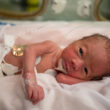Lots of images come to mind when we think of caring for our new babies. But have you ever thought of yourself as mama kangaroo and your newborn as baby Joey? “Kangaroo care” is the name for the practice of utilizing direct skin-to-skin contact between a parent and his or her child. The baby, diapered but otherwise unclothed, lays belly-down on the parent’s bare chest, with a blanket or robe or other covering laid over the baby’s back. It’s called kangaroo care because it mimics the marsupial model of caring for new babies, where young Joeys are kept in their mother’s pouch for security. Human babies are born the least mature of all mammals, so kangaroo care facilitates a baby’s continued growth and development in the safest place they can possibly be: physically close to an adult parent who loves them.
The benefits of kangaroo care for babies and moms
Skin-to-skin contact via kangaroo care is a wonderful thing for babies. It activates parts of a newborn’s brain that help them better digest and absorb the nutrients in their food. Newborns have very poor ability to regulate their temperature, and kangaroo care provides the perfect environment for optimal thermoregulation. Kangaroo care also stabilizes babies’ other vital signs, like heart rate and breathing, and helps them sleep better and cry less. It helps calm and soothe them, regulates their nervous system, and promotes better sleep/wake cycles. Premature babies need even more help than full-term babies to regulate these biological processes, so kangaroo care may be especially important for them.
And the benefits of kangaroo care extend to moms, too. When a mother spends time skin-to-skin with her newborn, that contact encourages better milk supply, improves mood, reduces postpartum bleeding, decreases stress, lowers the risk of postnatal mood disorders, and facilitates mother/baby bonding.
But kangaroo care isn’t something only moms can provide. Dads can do it, too! And a recent study in Australia likewise discovered that dads have even more to gain than previously thought from the superpower of skin-to-skin time [1].
Australian study: Skin-to-skin time for dads and babies matters, too
The Australian study focused specifically on 10 fathers who utilized kangaroo care for their babies during their neonatal intensive care unit (NICU) stay, for up to 6 weeks. All of the fathers were above 18 years old, spoke English, and experienced skin-to-skin contact for at least one episode lasting longer than an hour during their NICU stay. The methodology for the study was an exploratory qualitative descriptive approach, which allowed fathers to put their experiences into words.
NICU stays aren’t typically a relaxing experience for parents, and can bring on a lot of trauma and anxiety. But all of the dads in the study said cuddling through some skin-to-skin time with their baby enhanced their bonding, and they found it relaxing and enjoyable, even amidst the chaos and stress of a NICU stay. Admittedly, the sample size of 10 is very small, and it was only one NICU in Australia (rather than a handful of NICUS from all over the globe), but the fathers’ words were powerful. Some fathers reported that it affirmed their role as a caregiver, and gave them something important and tactile (quite literally!) to do.
Kangaroo care facilitated father-infant bonding
Fascinatingly, each father in the study described experiencing a specific progression of emotions during kangaroo care: first, each one felt nervous, followed by a feeling of calm and relaxation, progressing to enjoying the connection, and then to engaging with confidence. What the fathers were essentially experiencing was a “hierarchical and sequential” bonding process with their babies. The physical connection of kangaroo care fostered important and necessary neurological processes in phases that lead each father to bond with his or her new baby.
It’s been long known that mothers and babies belong together physically, but this was an exciting study because it showed that dads also have an important biological role in regulating their infant’s wellbeing, too.
Kangaroo care beyond the NICU setting
Kangaroo care doesn’t have to just stay in the NICU, either. Historically, kangaroo care has been encouraged especially for preterm or low-birth-weight babies and their parents, but there’s no reason it should be restricted to these dyads. Some parents decide to put these carrying principles into practice long after they come home from the hospital. This includes baby-wearing and contact napping, if so desired. Babies need lots of vestibular movement and close contact with their caregiver, which baby-wearing and contact movement provide in spades, respectively. And kangaroo care (especially when you utilize some type of carrier you can wear) fits the bill for both of these needs–closeness and movement. Kangaroo care also promotes a snug, warm environment similar to life in the womb.
The benefits of holding and keeping our babies close don’t expire when they exit the newborn phase. There’s a reason why you don’t (usually!) have sex with your clothes on. That skin-to-skin contact promotes bonding and closeness, because it helps activate parts of the parents’ brains that foster bonding, eliciting the release of the precious hormone oxytocin that fuels those warm fuzzy feelings. And all of these benefits are no less effective (though of course non-sexual) with an 8 month old baby than they are for a very young baby. Even when your toddler is sick and needs some extra cuddles, kangaroo care still has a place! At our biological core, humans are carrying mammals, so holding our babies close makes us—and them—happy.
Challenges to providing skin-to-skin time
Among the challenges to providing kangaroo care, at least in the United States, are the lack of both paid paternity and paid maternity leave, extended family or friend caregiver support for other children at home, and general financial barriers that make it hard for parents to be physically around in the weeks and months following a birth. The results of the Australian study suggest that improved parent-child bonding from kangaroo care is another potential benefit of employers prioritizing and providing paid parental leave. But whether or not your employer or your spouse’s employer offers this benefit, with the knowledge of just how beneficial kangaroo care can be, you can be intentional about spending time skin-to-skin with your newborn in whatever time you each do have available.
Make kangaroo care part of your postpartum plan
If this doesn’t have you wanting to cuddle a baby, I don’t know what will! If you are expecting and thinking about making your birth plan and postpartum plan, consider this your invitation to add “kangaroo care”—for both mom and dad—to your list. You, and your “Joey” have so much to gain!
Additional Reading:
“The Love Hormone:” what does oxytocin do for us?
The Fourth Trimester Guidebook: your postpartum mental health matters
References:[1] DipNur QD et al. “Exploratory study of fathers providing Kangaroo Care in a Neonatal Intensive Care Unit.” J Clin Nurs (2022). https://doi.org/10.1111/jocn.16405







